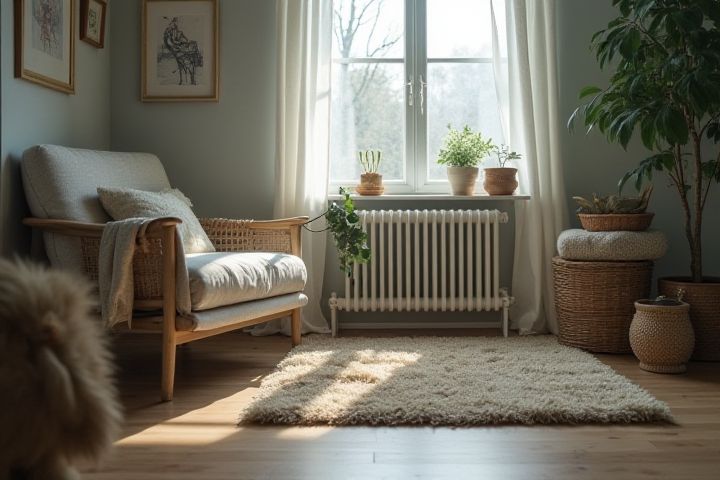
To effectively dehumidify your house, consider using a dehumidifier, which efficiently removes excess moisture from the air. Ensuring proper ventilation is crucial; open windows and use exhaust fans in areas prone to humidity, like kitchens and bathrooms. Sealing leaks and gaps around windows, doors, and foundations can also help prevent moisture infiltration. Incorporating absorbent materials like silica gel or activated charcoal can further aid in moisture control. Lastly, maintaining consistent indoor temperature levels through air conditioning can naturally reduce humidity levels, making your living space more comfortable.
Ways To Dehumidify A House
Use a portable dehumidifier
Using a portable dehumidifier is an effective method to reduce indoor humidity levels, particularly in areas prone to moisture buildup such as basements and bathrooms. These devices typically operate efficiently in spaces up to 1,500 square feet, extracting anywhere from 30 to 70 pints of moisture per day, depending on their capacity. To maximize efficiency, position the dehumidifier in a central location, allowing for optimal airflow and coverage. Regularly empty the water tank or connect it to a drain for continuous operation, ensuring your home maintains a comfortable humidity level between 30% and 50%.
Increase home ventilation
Increasing home ventilation is crucial for effective dehumidification, as it promotes air circulation and reduces moisture levels. Consider installing energy-efficient ventilation systems, such as exhaust fans or whole-house ventilation systems, which can lower indoor humidity by expelling damp air. Opening windows and doors during low-humidity days allows fresh air to enter and stale, humid air to escape, facilitating natural ventilation. Utilizing high-efficiency particulate air (HEPA) filters can further improve indoor air quality by trapping airborne moisture particles, enhancing your home's overall comfort.
Install an exhaust fan
Installing an exhaust fan in areas prone to moisture, such as kitchens and bathrooms, can significantly reduce humidity levels in your house. A properly sized exhaust fan can expel up to 50 cubic feet of air per minute, effectively removing excess moisture generated from cooking, showering, or washing. This not only helps prevent mold growth but also improves indoor air quality, making your living environment more comfortable. To maximize effectiveness, ensure that the fan vents directly outside and is used during activities that produce high humidity.
Use an air conditioner
An air conditioner effectively dehumidifies your home by removing excess moisture from the air during the cooling process. Most air conditioning units can reduce humidity levels by approximately 30% to 50% when properly sized and maintained. Ensuring that your unit operates continuously during humid months can further enhance its dehumidifying capabilities. Regularly replacing or cleaning the air filter also allows for optimal airflow, improving your unit's efficiency in maintaining a comfortable, low-humidity environment.
Use moisture-absorbing materials
Moisture-absorbing materials, such as silica gel, activated charcoal, and calcium chloride, are effective solutions for dehumidifying your home. Silica gel can absorb up to 40% of its weight in moisture, making it ideal for small, enclosed spaces like closets or drawers. Activated charcoal not only helps reduce humidity but also eliminates odors, providing a dual benefit for your living areas. For larger areas, calcium chloride can absorb moisture from the air, with a capacity of 10-20 times its weight, making it suitable for basements and other damp spaces.
Utilize a whole-house dehumidifier
A whole-house dehumidifier is an effective solution to reduce humidity levels, typically functioning efficiently in homes over 1,500 square feet. This system integrates with your HVAC setup, automatically regulating moisture by removing 10 to 14 gallons of water per day, depending on the model. Using this appliance not only improves indoor air quality but can also prevent mold growth and protect your furniture and appliances from moisture-related damage. Investing in a whole-house dehumidifier can significantly enhance your home's comfort, especially in regions with high humidity levels.
Keep windows open when possible
Keeping windows open when possible can significantly enhance indoor air circulation and reduce humidity levels in your house. This method allows fresh, drier outdoor air to flow inside, helping to displace moist, stagnant air. Optimal humidity levels for comfort and health range between 30% and 50%; keeping windows open can help you achieve this balance more naturally. In areas with lower humidity, ventilating your home through open windows can be a simple yet effective way to maintain a comfortable living environment.
Place houseplants that absorb humidity
Placing houseplants such as Boston ferns, peace lilies, or spider plants can significantly absorb humidity from your indoor environment. These plants' natural processes help reduce moisture levels, making your home feel more comfortable and preventing mold growth. For optimal results, maintain at least three to five humidity-absorbing plants per room, depending on the space size. Regularly water and care for these plants to ensure they remain healthy and effective in managing humidity levels.
Use silica gel packs
Silica gel packs are an effective way to dehumidify your home, especially in small, enclosed spaces such as closets and drawers. These granular packs can absorb up to 40% of their weight in moisture, making them ideal for controlling humidity levels. You can place silica gel packs in multi-pack options, which often cover up to 1,000 cubic feet when strategically positioned. To maximize their efficiency, remember to periodically replace or recharge the silica gel by drying them out under sunlight or in an oven at low temperatures.
Opt for energy-efficient appliances
Opting for energy-efficient appliances can significantly reduce humidity levels in your home. High-performance dehumidifiers, equipped with advanced technology, can remove up to 70 pints of moisture from the air daily while consuming less electricity. Additionally, energy-efficient air conditioning units regulate indoor humidity, ensuring a comfortable environment without excessive power consumption. By upgrading to these appliances, you not only improve your home's air quality but also lower your utility bills over time.
